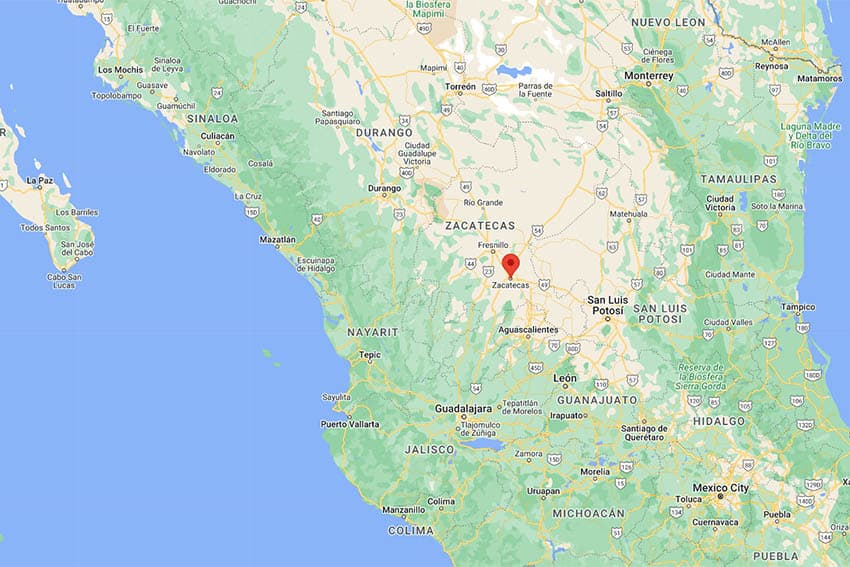
Zacatecas: An Overlooked Colonial Gem in the High Plateau
By Christina Lalanne

On the surface, Zacatecas might convincingly pass for a city ripped from the crowded and fertile valleys of Europe, then airlifted and abandoned with a no-nonsense thud onto Mexico’s high desert.
The notable absence of slums or narco-thugs, too, helps keep up the illusion of a prosperous Andalusian or Castillian university town.
But for all the continental resemblance, Zacatecas is much more central to Mexican identity than it might seem. It belongs, after all, to the country’s High Plateau region, a colonial heartland rich in Mexico’s own versions of Boston, Williamsburg, or Charleston.
Founded in 1546, three-quarters of a century before Plymouth Rock, a Spanish Empire intent on gold settled for some of the richest silver veins on earth. The mine they found, the Mina el Eden, is now a popular attraction plus an unlikely setting for the hottest disco in town.
But it was also an early grave for hundreds of natives pressed into compulsory service for the Spanish crown. Exploitation here would fuel a movement toward Mexican independence to explode two centuries later.
This history, along with a rich culinary heritage, makes the Bajio a tourism powerhouse for Mexicans, and perhaps “the next Tuscany” if it weren’t for the country’s real and imagined troubles elsewhere. Foreign tourists largely stay away, dipping their toes into the region at chic San Miguel de Allende or beauty-pageant-winner Guanajuato, if they come at all.
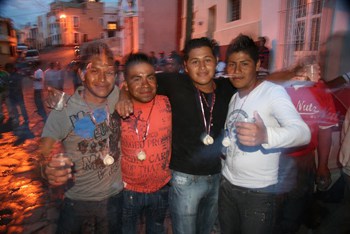
Party in the streets
This lack of “competing” foreigners, though, is an unexpected advantage of vacationing in Zacatecas. My travel companion and I were easily hijacked by a parade of Mexican revelers, a group set loose into the city’s narrow streets and on the heels of a brass band, with – what else – small vessels of tequila tied around their necks.
For locals used to this, the weekly callejoneada, it was us who had become the novelty.
“Zacatecas is the safest city in Mexico”, says local graduate student Israel Martinez, who almost didn’t come out that night but was glad he did for the chance to practice his English.
His cousin, known to friends as Pepe, dragged him out for an evening of drinking and dancing in the streets. Pepe, with drooping, friendly eyes, and a bit of roundness to his waistline is used to pals giggling at – what they insist – is his irrefutable resemblance to Winnie the Pooh.
Good fun and good people, the callejoneada has the familiar camaraderie of a collegiate fête. Guanajuato, the only other town in Mexico with a tradition of callejoneada, sends its musicians out into the streets dressed in 15th-century costumery complete with cloaks and buckled shoes to recruit tourists for the sober nightly party.

While still great fun, in Guanajuato it just isn’t as carefree (or as free, for that matter) and spontaneous as the Zacatecas version.
“You can have a boyfriend in America. And I can be your boyfriend in Mexico,” wooed another reveler, dispensing what appeared to be his personal arsenal of mezcal to strangers (mezcal is to tequila what sparkling wine is to champagne).
Select essentials aside, Zacatecas and the Bajio do not have many English speakers outside of the tourist industry so the area makes a far better immersion in the Spanish language than any of the well-trod student destinations in Europe.
Mexico’s Wild West
Distance, in addition to anonymity, is a hurdle keeping foreign travelers away. Getting here is a journey of 300 miles to the northwest of Mexico City.
Leaving the smog and strangling humanity of the capital city, entrance into the Bajio is marked by pastoral green valleys and dells which – at the opposite end of the region, essentially the last stop before the northern deserts – become a drier plateau thick with nopales, or prickly pear cactus.

At over 8,100 feet, travelers to Zacatecas experience a shortness of breath and a crisp climate unfamiliar in Mexico’s more-trafficked destinations.
Once here, the spoils of the old mining days are everywhere. Americans expecting the creaky wooden facades of once-wild frontier towns are instead impressed by a Main Street rich in the permanent stone workmanship of the Enlightenment.
In America’s Wild West, small clapboard chapels at the edge of the business district usually sufficed to offer the illusion of piety. But for the fanatical Spaniards, modesty simply would not do. Formal thanks to God for a prosperous town was finally dedicated in 1752.
The façade of the Cathedral is an explosion of stone: grapevines and angels surround niches occupied by apostles, bishops, and Jesus himself.
But this is no mere outdoor museum. The university lends a modern raison d’être to the city but Zacatecas functions as most Mexican towns do.

It is a riot of contemporary life, cluttered with taco stands, entertainers, loitering teenagers, and suited businessmen.
Balloon vendors and tuna (prickly pear fruit) stalls add color to the monochromatic soft pink sandstone. A gondola suspended over and across the town hints to street-level walkers that there must be something worth seeing from up there – and that there’s a lot more to this town than it gets credit for.
What to see
Zacatecas’ best sight is the city itself; be sure to allot enough time for simple wandering. Museum and attraction prices are low by American standards and vague curiosity is usually enough to justify the price of admission.
Ask your hotel or a local for directions to the tourist office for a map. Buildings not listed here but worth looking out for once you’ve been armed with that map include the Teatro Calderon, the Gonzalez-Ortega Market, the Aqueduct, and the former San Pedro Bullring.
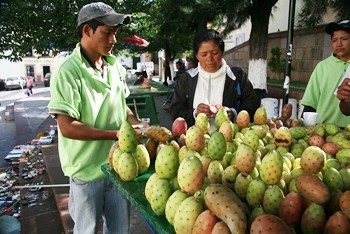
The Cathedral: This is widely considered to be one of the finest examples of Churrigueresque, or Mexican Baroque, architecture in the country. The interior warrants a look if only to witness modern-day piety; the once-lavish insides of the Cathedral have been stripped bare over the years in various waves of reform. The Cathedral, situated on Avenida Hidalgo is impossible to miss.
The Teleférico: The Swiss-built teleférico is perhaps Zacatecas’ only “must-see” sight. Visible in the sky throughout the historic city, it offers dramatic and spectacular views from above as it crosses the city center. 30 pesos one way. 40 pesos at night. Every day 8am-10pm.
Access is best by a short but steep walk – or a quick taxi – to the western terminus. Tourists can then tour La Bufa (see below) at the eastern end and make the longer and steeper walk down the hill back toward the city center.
Cerro de la Bufa: Though this historic hill was the site of Pancho Villa’s Battle of Zacatecas, foreign visitors are most likely to come for the teleférico and to wander past the pretty convent while enjoying the view over the city.

Rafael Coronel Museum: Housed in the atmospheric ruins of a 16th-century convent is this vast collection of indigenous and colonial masks assembled by a wealthy local patron.
The Spanish-only labeling and sheer volume of the collection might not hold attention spans for very long but the intricate, colorful, and often grotesque masks make this the most worthwhile museum in the city. 30 pesos. Open Thursday – Monday 10 am to 5 pm.
Mina el Eden: There are two entrances to this mine, the place responsible for the riches of the whole city. The north entrance is next to the western end of the teleférico and the south entrance is just beyond the historic center of town.
All commentary is given in Spanish, but no translation is needed to understand the claustrophobic and dangerous working conditions, made more comprehensible by staged dummies and props. 70 pesos. Open every day 10 am to 6 pm.
Juarez Garden: Set amidst pedestrian streets just behind Avenida Hidalgo, Juarez Garden is perhaps the quietest and prettiest spot in the city. It’s hard to imagine the stately little garden was converted to “better” use in the 1960s as a basketball court. Young lovers relax and former mansions overlook a square seemingly straight out of Seville.

Sightseeing tour: A variety of double-decker and trolley-buses wait in front of the Cathedral and depart for 40-minute tours around the streets of downtown. While the same ground can easily be covered on foot – and you’ll need fluent Spanish to understand the commentary – the inexpensive ride offers a lazily fun perspective over the city. Buses congregate just south of the Cathedral on Avenida Hidalgo. Fares are generally 40 pesos for an adult for a 45-60 minute tour.
Where to stay
Hostal Villa Colonial: This budget hotel and hostel is the friendliest place to stay in town. The location behind the Cathedral is convenient and the rooms are clean and comfortable. For a bit more privacy, it’s worth asking to stay in one of the rooms in their alleyway property across the street. Free wifi and a gorgeous view from the rooftop bar add to the charms.
A place like this at these prices is becoming increasingly difficult to find in Mexico City or the resort towns, making extended stays in Zacatecas even more attractive. hostalvillacolonial. Dorm bed, 100 pesos; private room with shared bath, 190 pesos; private room with private bath, 250 pesos. +52 (492) 922-1980. Calle Primero de Mayo at Callejon del Mono Prieto.
Hotel Emporio Zacatecas: Housed in a former mansion right on the main drag, the rooms and large beds will suit Americans happy with Best Westerns or Holiday Inn Expresses back home, but at a better price. A business center, a gym, parking, and a swimming pool also keep guests comfortable. hotelesemporio.com. Rooms start around $80 US when booked online. Avenida Hidalgo 703.

Hotel Quinta Real: Often touted as one of the most distinct hotel properties in Mexico, the Quinta Real has been stylishly dropped into a former bull ring.
If luxury is what you’re after, this is the best place to find it. But unless you need a refuge from the “color” of Mexico, you might find the place a bit sterile. Even a drink at a bar that once held fuming beasts is dull. quintareal.com. Calle Gonzalez Ortega.
Where to eat
Mezcal, like tequila, is made from the agave plant and is traditionally imbibed in Zacatecas. Also try the fruit of the prickly pear cactus, sold at stalls throughout the town; vendors will peel away the sharp thorns to reveal the sweet, melon-like fruit inside.
Los Dorados de Villa: The walls at this colorful neighborhood restaurant are lined with memorabilia celebrating Pancho Villa’s revolutionary army. Still, the décor can’t compete with the food, which – if you had a Mexican grandmother – might be the sort of loving, quality food she would guilt you into finishing. The house salsa is some of the best anywhere, as are the enchiladas. Arrive hungrily and don’t be put off by the heavy locked door; just keep knocking. Open at 3 pm daily. Near the Rafael Coronel Museum on Plazuela de Garcia. +52 (492) 922-5722.

La Unica Cabana: The atmosphere is more institutional than at Los Dorados de Villa but the tacos are excellent. Mix and match at this popular local spot and don’t hesitate to experiment: everything’s cheap. Calle Independencia at Calle Juarez.
Sanborn’s: Serving moderately-priced, standard versions of Mexican – and American – staples, a trip to this national chain is useful for squeamish gringo stomachs or for the fine views from the second-floor balconies of this former mansion. The entrance is through the first-floor department store. Avenida Hidalgo 212.
Going out
Zacatecas actually has quite a few hoppin’ spots due to all the students. Ask at your hotel for bars with drink specials on particular nights. If you’re not a big partier, consider grabbing a table on a balcony before the late-night crowd comes in (see La Bartola below), an evening ride on the teleférico, or checking out the stepped square just south of the Gonzalez-Ortega Market for public performances.

Callejoneada: It’s worth timing a visit to Zacatecas on a Friday or Saturday to participate in this spirited, horns-heavy party through the streets. Ask first at your hotel, but groups generally gather on the north side of the Cathedral at around 8 pm, dispensing mezcal and dance offers for about two hours.
La Mina: While it would be gimmicky in any other city, this disco-within-a-mine manages to be the hottest dance club in town, full of university students and Mexican tourists. Entrance varies by the hour and night of the week, but peak times can demand as much as 200 pesos per person. Mina el Eden main entrance, roughly 10 pm to 3 am.
La Bartola: If you can grab a table on a balcony overlooking Avenida Hidalgo, it’s well worth having a few beers or tequilas as you enjoy your view below. There are also café tables set out into the square behind the main drag. 322 Miguel Auza. A bit difficult to locate the entrance to a block west of Avenida Hidalgo find the San Agustin church; the entrance to the café is across the street (towards Hidalgo).
How to get here

Air: Volaris Airlines flies direct from Los Angeles International Airport (LAX). Otherwise, connections in Mexico City are necessary. Flying to the Guadalajara airport (GDL) is cheaper and opens up more flights for those coming from abroad; Guadalajara is 5 hours away by bus.
Bus: Mexico has an excellent first-class bus system that surprises Americans used to Greyhound back home. For schedules, check the company websites of Primera Plus or ETN. Mexico City to Zacatecas is roughly 8 hours; from Guadalajara, it’s 5 hours.
Safety
Mexico’s security and drug issues are serious. While there is evidence the problems are spreading, violence is generally contained within the northern border states. Tourists are not targeted and the middle and southern regions of the country are as safe as they have always been.
The dangers are very much exaggerated: imagine yourself in the 1930s and being too afraid to visit the United States because you had heard dozens of media reports about mafia and gang violence in Chicago or New York.
Then, as now, your chances of being involved in something dangerous are extremely slim. Middle-class university towns like Zacatecas and Guanajuato especially feel more vibrant and safer than most North American cities.
Women will experience lots more attention – generally in the form of whistling – than they’re used to back home. Usually harmless, remember that Mexican culture is very family-oriented; appealing to local women will keep persistent suitors away.
 Christina Lalanne is a San Francisco tour guide who leads private walking tours through her website sfwalks.com.
Christina Lalanne is a San Francisco tour guide who leads private walking tours through her website sfwalks.com.
- Camino Tales: Wine and Memories in Galicia, Spain - July 25, 2024
- Beluga Hunting in Norway - July 20, 2024
- Costa Rica: A Rainforest Chocolate Tour - July 18, 2024


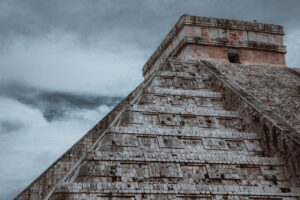
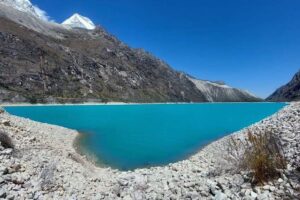


Thank you for writing this. I am from Zacatecas and appreciate what you wrote about our state and city! I hope more people add Zacatecas as a destination during a trip to Mexico as it is very well worth it!